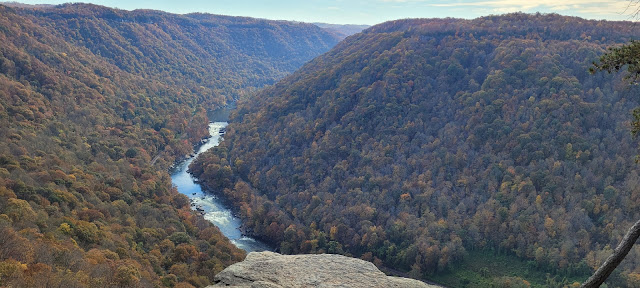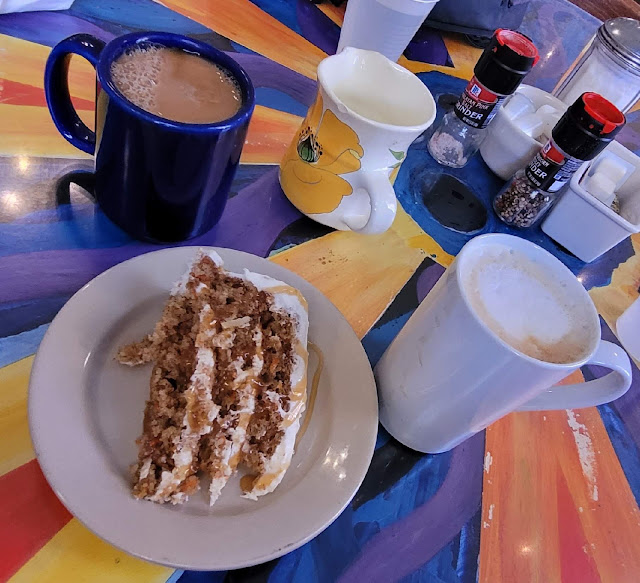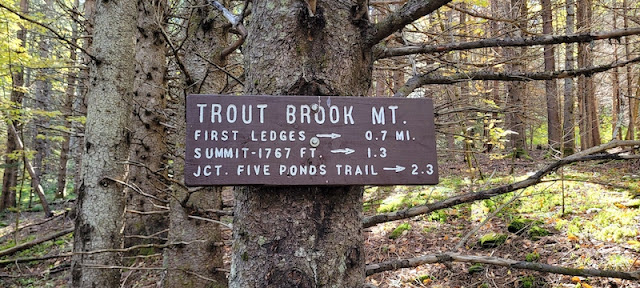October 22, 2022
Who would think what happened on earth 270 million years ago would influence our cross-country road trip from Virginia to California? In fact, the earth, the land, the wildlife, the birds, the trees, and the limestone under the ground all played an essential part in our adventures from the East to West Coast.
A billion years ago, the earth’s land formed one supercontinent. The crust of the supercontinent began to thin and pull apart 750 million years ago. A basin formed and filled with seawater and marine sediment. The sea retreated, returned, retreated, returned, and retreated again, leaving behind millions of years of limestone-rich deposits. The continents broke apart 540 million years ago.
 |
We hiked the Forest Exploration Trail to the Loop Forest Trail at Pocahontas State Park in Chesterfield County, Virginia. |
Weather eroded the small, soft sediment and left behind larger and harder pebbles and rocks. The continents began to move toward each other again 470 million years ago. The eastern continent pushed the rocks westward, collided with another continent, and forced the land mass upward, piling up the rocks to form the Appalachian Mountains 270 million years ago.
The Appalachian Mountains were once as big and rugged as the Rocky Mountains. Hundreds of millions of years of erosion have softened the peaks now covered in forests and home to white-tailed deer, moose, black bears, bobcats, the Eastern coyote, beavers, raccoons, American porcupines, fishers, river otters, and snowshoe hares.
 |
Amanita cokeri, this large, poisonous mushroom, grows in the woodlands of Virginia. |
Smaller, softer sediment washed eastward, forming Piedmont, or foothills, Virginia’s fertile farmland where horses and cows graze from Charlottesville to Richmond and Fairfax to Roanoke.
The earth told Virginia's first people—the Powhatan, the Monacan, the Occaneechi, the Tutelo, the Sapony, the Cherokee, the Mannahoac—how and where to travel—around its mountains, over its ridges, and across its rivers. We thank the native people of this land on whose trails we travel.
Ultimately, the landscape created ideal conditions and flavored the water just right to make the best bourbon anywhere. It carved out limestone caves far under the ground that we explore today all while sheltering animals long enough for them to evolve into unique creatures (cave fish and amphibians). It grew the trees where birds flit and flutter—trees that made the wood we cut and turn to make baseball bats and bourbon barrels.
Highly pressurized layers of earth created coal, copper, gold, silver, and petroleum deep underground. Opportunists flocked to the land to get rich. Communities and economies rose and fell or sometimes disappeared altogether, leaving behind a barren and defiled land that even the factories didn't want anymore.
 |
Beginning to see the rise of the Valley and Ridge Province of the Appalachian Mountains, just west of the Blue Ridge. |
In this article, we interrupt stories about our Fall 2021 trip to write about our latest trip: Fall 2022 Cross Country or #Fall22XCountry. We traveled from Midlothian, Virginia, to Palm Springs, California, in our 1996, 19-foot Dodge Pleasure Way RV van, recently named Sweet Van-Ella Magnolia, or Ella for short.
We retrieved Ella from Genito Mini Storage in Midlothian, where she had been in storage since the end of our 2021 New England Fall Foliage trip.
We drove through the Piedmont region on I-64 to Charlottesville, Virginia, made a pitstop, then drove another two hours on winding country roads through Churchville and Monterey through the mountains of western Virginia. We passed farms and pastures full of horses, Black Angus cattle, and flocks of sheep. When Ella reached the top of a pass, the view opened up to a beautiful vista of soft mountain peaks covered in rusty shades of gold, orange, red, and green.
 |
Campsite #5 at Seneca State Forest, also known as Seven Mile Campground. |
We turned onto Highway 220 in Monterrey and soon crossed into West Virginia. Then on Route 92, Google wanted us to hang a left onto a country road to cross over a ridge to reach route 28, which would take us to the campground. That little road looked too country for us and our van, and we continued on 92 and met 28 a few more miles down the road. Another reminder that Google's directions are suggestions, and we should preview them before starting out for the day.
 |
Our route from Midlothian, Virginia, to Seven Mile Campground in the Seneca State Forest, West Virginia. |
We had downloaded offline maps, having been warned that this is a radio-free zone with no Internet or cell phone reception. According to Wikipedia, “The National Radio Quiet Zone (NRQZ) is a large area of land in the United States designated as a radio quiet zone, in which radio transmissions are heavily restricted by law to facilitate scientific research and the gathering of military intelligence.”
 |
Our stay at Seneca Forest Campground was the best camping experience on the whole trip. |
Our first two nights were at Seneca State Forest Campground, also known as Seven Mile Campground. We arrived at site #5, situated next to a leaf-covered slope of hardwood trees. This small campground with only 10 sites is by reservation only. The site next to us was occupied, as was one further down the campground road. Other than a few cars on the highway and the dried leaves rustling in the breeze or scampering squirrels, it was quiet.
We made a fire in the stone firepit (the $6 camp wood not terribly dry) and ate a dinner of BBQ pork and pasta salad. Roger was reminded to always maintain some dry kindling and newspapers for starting fires with wet campground wood. He had to resort to his old Boy Scout trick for starting a fire using a small wad of duct tape sprayed with WD40 and placed in a paper bag.
 |
First-night selfie! |
Nighttime temperatures were chilly. Ella’s heater worked at first but then stopped reigniting during the night. Only the fan blew. Luckily, our sleeping bags were rated for cold weather. We woke to chilling temps and donned knit caps for coffee hour.
October 23, 2022
After a leisurely morning of coffee, reading, writing, and breakfast, we made our way over the mountain and through the woods on the narrow, winding Laurel Run Road to Clover Lick Depot. I didn’t think it was wide enough for two cars to pass. Roger said there was plenty of room and proved it when a pickup met us coming the other way.
At the other end of Laurel Run Road, a narrow, wooden bridge crossed the Greenbrier River, and Clover Lick Depot, one of the designated trailheads of the Greenbrier River Trail, was on the right.
 |
The Clover Lick Depot is 10 miles northeast of Marlinton, West Virginia. |
We geared up and were on our way. The trail, a former railbed between Caldwell to the south and Cass to the north, is 80 miles long. We rode out and back about 14 miles roundtrip. We met two couples traveling together on rented e-bikes. They used a shuttle service from Marlinton, where they were staying in a hotel, to drop them off at Cass. They rode one-way back to Marlinton.
 |
Autumn leaves often covered the trail. |
Assisted bikes were not necessary for this trail, but they make access to beautiful places like this possible for people who might have difficulty pedaling a regular bicycle. The trail was mostly level and dry (just a few muddy spots) with double, packed paths. Mountain bikes were not needed. We rode street bikes.
 |
The trail follows the scenic Greenbrier River adorned in its coppery reflections of late October foliage. |
The most unique aspect of the trail was Sharp’s Tunnel, a deceptively long and dark tunnel at around mile marker 65. The tunnel’s center was pitch black, and we had no depth perception. We rode through the tunnel on blind faith that the path below us was clear and solid. On our return trip, we met people coming from the other direction. We would have run into them if they hadn’t had a light.
 |
Sharp’s Tunnel was straight out of a Roadrunner cartoon. |
The trail also featured beautiful white stone and cement mile markers every five miles. The Greenbrier River Trail website has a downloadable map that comes in handy because there is no phone service in this radio-free zone. The map displays the mile markers, campsites, rest stops, and special features along the way.
 |
Some people take several days to ride and camp along the entire 80-mile trail. |
We rested, ate a picnic lunch at the rest stop beyond the tunnel, and then headed back. Total trail time was about 3.5 hours at a comfortable pace with plenty of time for photos. The temperature on this sunny day warmed up after a chilly morning, and we rode in shorts and t-shirts. Along the way, the trail has porta-potties and old-fashioned water pumps for refilling water bottles. (FYI - No bathroom at Clover Lick Depot.)
We returned to Seneca State Forest / Seven Mile Campground at around 4 pm. Roger marinated boneless, skinless chicken thighs with his special Rusty Chicken recipe and cooked it on the open fire. With our bellies full of chicken, deli potato salad, and a few happy hour cocktails, we slept well through the night.
During the morning hours in the Seneca Forest, my Merlin bird Sound ID app identified a blue jay, a white-breasted nuthatch, a golden-crowned kinglet, a house sparrow, a Carolina wren, a northern flicker, a northern titmouse, and a red-breasted nuthatch. I heard an owl in the evening hours but wasn't quick enough to ID it with the app.
*Subscribe to our blog, and we’ll send you a copy of Roger’s Rusty Chicken Recipe.*
 |
Roger in his glory—cooking over an open wood fire. |
Monday, October 24, 2022
We reluctantly left the Seneca Forest. One of our favorite campgrounds anywhere. We drove southwest toward New River Gorge with a stop at the public library in Marlinton to request our Electronic/Online Delivery Absentee Ballots from the Alaska Division of Elections.
The McClintic Public Library had a set of computers for public use and a friendly and helpful librarian. It also had a pay-what-you-want used book sale in the corner of the library, and I paid one dollar for a copy of Braiding Sweetgrass by Robin Wall Kimmerer.
Marlinton, the Pocahontas County seat, also has one of the more popular trailheads to The Greenbrier River Trail. Marlinton is full of railroad and logging history. It’s a great small-town destination.
We drove US 219 South, also known as the Seneca Trail, through the mountains of Pocahontas County and along the James River and Kanawha Turnpike Ha! Turnpike! The “turnpike” must have been a joke the locals pull on tourists. The narrow, twisting, turning road almost made me car sick. I can’t praise Roger’s driving skills and patience enough.
"Finally, we entered hill country, climbing higher and deeper into the Appalachian Mountains, stopping from time to time to let the Oldsmobile catch its breath on the steep, twisting roads. It was November. The leaves had turned brown and were falling from the trees, and a cold mist shrouded the hillsides. There were streams and creeks everywhere, instead of the irrigation ditches you saw out west, and the air felt different. It was very still, heavier and thicker, and somehow darker. For some reason, it made us all grow quiet." — The Glass Castle by Jeannette Walls
We arrived at Chestnut Creek Campground in full sunshine. This primitive-style campground was near the national park visitor center. A young family owned it, and their flock of chickens roamed freely. We selected site #30 because it was closest to the bathhouse.
 |
Site #30 at the rustic Chestnut Creek Campground. |
Although primitive, the campground had flush toilets and showers. Designed for tent campers, this campground had a relaxed and quirky style. The gravel road to the campground was bumpy, so be prepared and don’t try to drive it with a big RV. The park advertises wilderness-style camping—a place you can pull in for the night and get a shower if you have a small footprint.
 |
Despite its name, the New River is not new. The river carved the gorge over the previous three million to 350 million years. |
Other campers were rock climbers—three guys from Louisville tent camping and a woman from New York traveling in a newer Dodge 3500. She was in the process of converting it and gave Roger a tour. Offering a tour of your van home is an unofficial van travel courtesy. RV travelers, in general, like to share ideas for power, batteries, storage, solar, heat, water, and refrigeration.
The weather was warm that day, and tiny gnats swarmed the campsite. We called it an early night and retreated to bed.
Tuesday, October 25, 2022
We got the van road ready early the next morning and drove to the trailhead of the Endless Wall Trail. The New River, which is actually older than the Appalachian Mountains, cut through the Appalachian Plateau and exposed rocks more than 330 million years old.
 |
A scenic overlook on the Endless Wall Trail. |
After the Visitor Center, we drove the winding, one-way Fayette Station Road Audio Tour to the bottom of the gorge. The audio is available online, syncs with driving time, and describes the area’s coal mining, logging, and railroad history. Fayette Station Road was the main travel route for nearly 100 years.
 |
Our Sweet Van-Ella at the bottom of the New River Gorge near Fayette Station Rapid. |
We explored the nearby town of Fayetteville with kaffeetrinken at the Cathedral Cafe, which specializes in local and seasonal ingredients and features Equal Exchange Fairly Traded coffee, tea, chocolate, and food products. The cafe is located inside a former church and is home to a self-serve used book exchange. Books are free or by donation. Proceeds benefit the local animal shelter, women’s shelter, and food pantry.
We returned to the campground and were woken early by roosters crowing at the dawn. Time to hit the road and on to our next adventure—bourbon, baseball, and bats.
Resources:
The Piedmont Region of Virginia (Retrieved, 12/22/2022)
West Virginia Economical and Geological Survey (Retrieved, 12/22/2022)
Birth of the Mountains (Retrieved, 12/22/2022)
National Park Service, various brochures & websites
Further Reading:
Roadside Geology of West Virginia by Joseph Lebold and Christopher Wilkinson
The Glass Castle by Jeannette Walls
Edited 12/28/2022
© copyright 2022. Patricia E. Harding. All rights reserved.



























